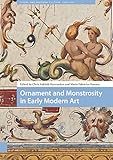Ornament and Monstrosity in Early Modern Art / ed. by Maria Fabricius Hansen, Chris Askholt Hammeken.
Material type: TextSeries: Visual and Material Culture, 1300 -1700 ; 13Publisher: Amsterdam : Amsterdam University Press, [2019]Copyright date: ©2019Description: 1 online resource (282 p.) : 89Content type:
TextSeries: Visual and Material Culture, 1300 -1700 ; 13Publisher: Amsterdam : Amsterdam University Press, [2019]Copyright date: ©2019Description: 1 online resource (282 p.) : 89Content type: - 9789048535873
- Art -- Europe -- 16th century -- Themes, motives
- Art, European -- 16th century -- Themes, motives
- Decoration and ornament -- Europe -- 16th century -- Themes, motives
- Decoration and ornament -- Mexico -- Ixmiquilpan -- 16th century -- Themes, motives
- Grotesque in art
- Monsters in art
- Mural painting and decoration -- Mexico -- Ixmiquilpan -- 16th century -- Themes, motives
- Mural painting and decoration, Mexican -- 16th century -- Themes, motives
- Art and Material Culture
- Early Modern Studies
- History, Art History, and Archaeology
- History
- ARCHITECTURE / Decoration & Ornament
- Early modern and Renaissance art, artificiality, playfulness, ambiguity, anxiety, ornament
- 709.031 23
- NK1330
- online - DeGruyter
| Item type | Current library | Call number | URL | Status | Notes | Barcode | |
|---|---|---|---|---|---|---|---|
 eBook
eBook
|
Biblioteca "Angelicum" Pont. Univ. S.Tommaso d'Aquino Nuvola online | online - DeGruyter (Browse shelf(Opens below)) | Online access | Not for loan (Accesso limitato) | Accesso per gli utenti autorizzati / Access for authorized users | (dgr)9789048535873 |
Frontmatter -- Contents -- List of Illustrations -- Introduction -- Part I. Grotesques -- 1. Ambiguous Delights: Ornamental Grotesques and Female Monstrosity in Sixteenth-Century Italy -- 2. Dissonant Symphonies: The Villa d'Este in Tivoli and the Grotesque -- Part II. Sacred Space and Narrative -- 3. Outside-In: The Intrusion of Ornament into Sacred Narrative -- 4. 'That savage should mate with tame': Hybridity, Indeterminacy, and the Grotesque in the Murals of San Miguel Arcángel (Ixmiquilpan, Mexico) -- 5. Decoration in the Desert: Unsettling the Order of Architecture in the Certosa di San Martino -- Part III. Agency and Ornament Enlivened -- 6. Masquing/(Un)Masking: Animation and the Restless Ornament of Fontainebleau -- 7. Sea-Change: The Whale in the Florentine Loggia -- 8. Ornament and Agency: Vico's Poetic Monsters -- Part IV. A Historical Perspective -- 9. Trafficking the Body: Prolegomena to a Posthumanist Theory of Ornament and Monstrosity -- Index
restricted access online access with authorization star
http://purl.org/coar/access_right/c_16ec
Early modern art features a remarkable fascination with ornament, both as decorative device and compositional strategy, across artistic media and genres. Interestingly, the inventive, elegant manifestations of ornament in the art of the period often include layers of disquieting paradoxes, creating tensions - monstrosities even - that manifest themselves in a variety of ways. In some cases, dichotomies (between order and chaos, artificiality and nature, rational logic and imaginative creativity, etc.) may emerge. Elsewhere, a sense of agitation undermines structures of statuesque control or erupts into wild, unruly displays of constant genesis. The monstrosity of ornament is brought into play through strategies of hybridity and metamorphosis, or by the handling of scale, proportion, and space in ambiguous and discomforting ways that break with the laws of physical reality. An interest in strange exaggeration and curious artifice allows for such colossal ornamental attitude to thrive within early modern art.
Mode of access: Internet via World Wide Web.
In English.
Description based on online resource; title from PDF title page (publisher's Web site, viewed 02. Mrz 2022)


